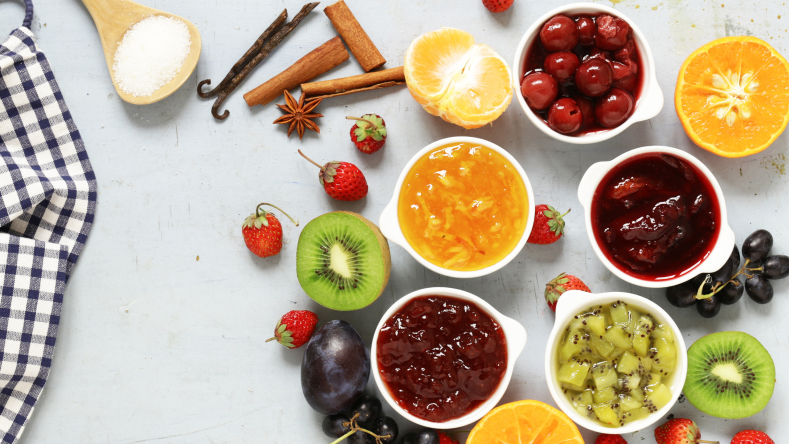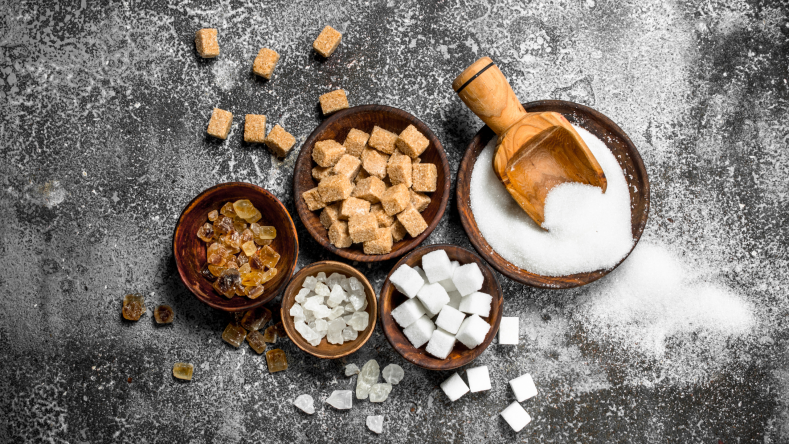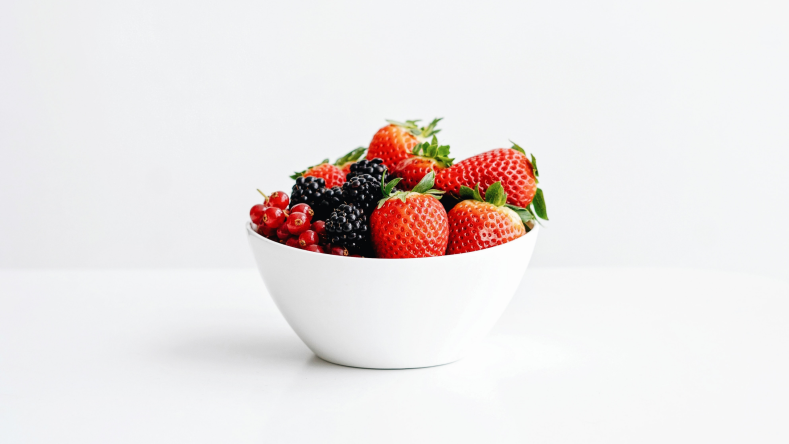Does fructose lead to weight gain? Here’s what science has to say.
Experts agree that consuming too much added sugar can wreak havoc on your health, but where does fructose fit into this equation? While fructose naturally occurs in fruit, it is also used in a myriad of processed foods, which when consumed in excess, could affect the number on the scale. Here’s what science has to say about fructose and weight gain.

Like it or not, sugar is present in almost everything you eat. From fruit and chocolate to wine and tomato sauce, this sweetener is found in both natural and processed foods, so it can be difficult to sort through the noise and determine which sugars negatively affect your health or offer benefits.
While sugar can be enjoyed in small amounts, experts agree that consuming excess fructose (by way of added sugars) takes a toll on your body and can lead to unwanted side effects. But is weight gain one of them?
Before exploring if fructose leads to weight gain, let’s first understand what sugar is, if there is a difference between natural and refined sugars, and where fructose fits into that equation.

Understanding sugar
Sugar is a soluble carbohydrate that your body converts into glucose and uses for energy. The two main categories of sugars are monosaccharides (“simple” sugars that consist of one molecule) and disaccharides, which consist of two monosaccharide molecules joined together. There are also different types of sugar (such as dextrose, fructose, galactose, glucose, lactose, maltose, and sucrose) which can be classified as either natural or refined sugars.
What is fructose?
Fructose is a monosaccharide that is found in many plants–like sugar cane, sugar beets, and corn–and can bond with glucose to create sucrose (table sugar) [ 3 10
Fructose naturally occurs in fruit, agave syrup, and honey, but it can also be added to processed foods and beverages in the form of high fructose corn syrup (HFCS). Foods with high fructose corn syrup include, but are not limited to, candy, sugary beverages, fast food, baked goods, sauces, bread, jams, jellies, and applesauce.
Fructose vs. glucose
While fructose and glucose are both monosaccharides and come from natural sources, there are a few key differences between the two.
Glucose: Glucose is responsible for supplying energy to the brain, muscles, and other body organs and tissues [
21
]. It’s also the building block for other structural molecules in your body (such as glycoproteins and glycolipids), and is naturally found in fruits, grains, beans, vegetables, nuts, and molasses. However, it can also be found in processed foods and is considered to be an added sugar when used outside of its natural state.Fructose: Contrary to glucose, fructose is metabolized in the liver and is used to replenish liver glycogen and synthesize triglycerides [
10
]. As such, studies have found that a diet high in fructose (by way of added sugars) may overload the liver and increase fat deposition, which can contribute to a range of metabolic problems [11
].
When it comes to fructose vs. glucose, it’s best to consume them in their natural forms, as experts agree that all types of added sugar are more damaging than sugar naturally found in foods.
Natural sugar vs. added sugar
Not all sugar is created equal. Here’s what science has to say about natural sugar vs. added sugar.

Natural sugar
As the name suggests, these sugars occur naturally in fruit (fructose), vegetables, grains, and dairy products (lactose). Thanks to the fiber and protein present in these foods, the natural sugars are digested and absorbed into the bloodstream at a slower rate, thus providing a steady supply of energy to your cells. They also contain other essential nutrients, like vitamins, minerals, and antioxidants, that are needed for energy metabolism, immune function, cell health, and more. Moreover, a diet rich in fruits and vegetables can help reduce the risk of chronic diseases, such as diabetes, heart disease, and some cancers.

Refined sugar
This type of sugar is processed from sugar cane or sugar beets and is typically found as sucrose (a combination of glucose and fructose). Unlike naturally occurring sugars in whole foods that are typically paired with fiber and/or protein, your body rapidly breaks down refined sugars causing insulin and blood sugar levels to spike. Additionally, refined sugars contribute a large number of calories but have little nutritional value otherwise [ 1 22
High fructose corn syrup vs. sugar
High fructose corn syrup is a type of refined sugar that is derived from corn syrup, and is used as a cheap additive by many food manufacturers to sweeten food. Unfortunately, studies have found that the fructose in HFCS is associated with an increased risk of fatty liver disease, obesity, inflammation, heart disease, and type 2 diabetes [ 4 5 6 7
HCFS appears to come with similar downsides to other forms of added sugar. Studies have found that any added sugar which contains fructose or galactose can’t be used by the body, and will instead be converted to glycogen, uric acid, and lactic acid (all which are harmful in large quantities) [ 8 9
How many grams of added sugar per day?
Added sugars provide limited nutritional value or health benefits, which is why the American Heart Association recommends limiting added sugars to no more than 6% of calories/day [ 2
Men: No more than 150 calories/day (36 g or 9 teaspoons)
Women and children aged 2+: No more than 100 calories/day (25 g or 6 teaspoons)
Children under 2: Added sugar is not recommended
Fructose and weight gain
According to the Dietary Guidelines, the average American consumes 270 calories (or 17 teaspoons) of sugar/day, which is significantly higher than the recommended amount [ 12
Here are some ways that excess fructose consumption (by way of added sugars) can negatively impact the number on the scale.
Insulin resistance.
Excess fructose consumption has been found to have a negative impact on insulin. Studies show that fructose doesn’t stimulate insulin secretion from pancreatic β cells, which can impair insulin signaling and may lead to obesity and type 2 diabetes [ 14 15
Might promote overeating.
Research shows that those who consume excess fructose may have a tendency to overeat. When measuring brain activity in people who consumed fructose, researchers discovered that the areas of their brains which regulate appetite (like the hypothalamus, insula, and striatum) and control satiety were not affected, which might trigger overeating [ 16 17
Leptin resistance.
Increased fructose intake has been associated with leptin resistance which may promote obesity [ 18
Increased caloric intake.
It’s estimated that fructose accounts for 10% of caloric intake in the US thanks to the addition of HFCS found in many soft drinks and processed foods [ 13

How to curb fructose intake
Cutting back on refined sugar may be challenging at first, but it gets easier over time. Here are some ways you can reduce your fructose intake, reduce the risk of chronic disease, and help manage your weight.
Don’t shy away from fruit. Fruit isn’t your enemy! While it’s a natural source of fructose, it also provides a plethora of vitamins and minerals that contribute to overall health. So, instead of adding sugar to your morning oatmeal, reach for some fresh fruit–this will provide added flavor and nutrition while satisfying your sweet tooth.
Limit sugar-laden drinks. Fructose can be found in many processed drinks–like fruit juices, sodas, cocktail mixes and energy drinks–so it’s best to limit these items and choose non-added sugar beverage alternatives instead. Water is best, but if you want something else to drink, fruit-infused water or seltzer with a squeeze of fresh citrus are other healthful choices.
Choose more whole foods. Whole foods like fruits, vegetables, whole grains, and legumes are free of additives and other preservatives (such as HFCS). By keeping these items in your kitchen, it may be easier to cut back on high-sugar foods.
Engage in physical activity. Studies show that physical activity can offset the negative effects of a high-fructose diet and may even decrease
cardiovascular risk factors
[19
]. While any amount of activity is better than none, aim for 30 minutes of exercise/day for optimal benefits.Read the label. It’s estimated that 75% of packaged foods contain added sweeteners (such as brown sugar, corn sweetener, HFCS, honey, malt syrup, molasses, and turbinado sugar), so it’s recommended to read food labels before purchasing [
20
].
Summary
Fructose is a monosaccharide that naturally occurs in fruit, but food manufacturers often use it in the form of high fructose corn syrup (HFCS) to sweeten food. Studies have found that HFCS has been associated with a host of health issues (such as fatty liver disease, inflammation, heart disease, and type 2 diabetes), and can even lead to weight gain or obesity. Eating more whole foods, cutting back on sugar-laden beverages, and engaging in physical activity are just some of the ways you can reduce your fructose consumption, manage your weight, and improve overall health.
Disclaimer: The text, images, videos, and other media on this page are provided for informational purposes only and are not intended to treat, diagnose or replace personalized medical care.
Key takeaways
Fructose is a monosaccharide that is found in many plants–like sugar cane, sugar beets, and corn–and can bond with glucose to create sucrose (table sugar) [
3
].Fructose naturally occurs in fruit (like apples and pears), agave syrup, molasses, and honey, but it can also be added to processed foods and beverages in the form of high fructose corn syrup (HFCS).
Studies have found that the fructose in HFCS can wreak havoc on health, as it’s been associated with an increased risk of fatty liver disease, obesity, inflammation, heart disease, and type 2 diabetes [
4
,5
,6
,7
].Increased fructose intake has been associated with leptin and insulin resistance which may promote obesity [
14
,15
,18
].It’s estimated that fructose accounts for 10% of caloric intake in the US thanks to the addition of HFCS found in many soft drinks and processed foods [
13
].
References
The sweet danger of added sugars - E.J.P.D. (n.d.). Retrieved March 21, 2022, from
https://www.ejpd.eu/pdf/EJPD_2019_20_2_1.pdf
Added sugars. www.heart.org. (2021, November 2). Retrieved March 21, 2022, from
https://www.heart.org/en/healthy-living/healthy-eating/eat-smart/sugar/added-sugars
Macdonald I. A. (2016). A review of recent evidence relating to sugars, insulin resistance and diabetes. European journal of nutrition, 55(Suppl 2), 17–23.
https://doi.org/10.1007/s00394-016-1340-8
Faeh, D., Minehira, K., Schwarz, J. M., Periasamy, R., Park, S., & Tappy, L. (2005). Effect of fructose overfeeding and fish oil administration on hepatic de novo lipogenesis and insulin sensitivity in healthy men. Diabetes, 54(7), 1907–1913.
https://doi.org/10.2337/diabetes.54.7.1907
Stanhope, K. L., Schwarz, J. M., & Havel, P. J. (2013). Adverse metabolic effects of dietary fructose: results from the recent epidemiological, clinical, and mechanistic studies. Current opinion in lipidology, 24(3), 198–206.
https://doi.org/10.1097/MOL.0b013e3283613bca
Ludwig, D. S., Peterson, K. E., & Gortmaker, S. L. (2001). Relation between consumption of sugar-sweetened drinks and childhood obesity: a prospective, observational analysis. Lancet (London, England), 357(9255), 505–508.
https://doi.org/10.1016/S0140-6736(00)04041-1
Bantle J. P. (2009). Dietary fructose and metabolic syndrome and diabetes. The Journal of nutrition, 139(6), 1263S–1268S.
https://doi.org/10.3945/jn.108.098020
General Nutrition Guidelines for Glycogen storage disease ... (n.d.). Retrieved March 21, 2022, from
https://ufhealth.org/sites/default/files/media/GSD/General-Nutrition-Guidelines-for-Glycogen-Storage-Disease-Type-I.pdf
Schaefer, E. J., Gleason, J. A., & Dansinger, M. L. (2009). Dietary fructose and glucose differentially affect lipid and glucose homeostasis. The Journal of nutrition, 139(6), 1257S–1262S.
https://doi.org/10.3945/jn.108.098186
https://www.sciencedirect.com/topics/food-science/high-fructose-corn-syrup
Rizkalla S. W. (2010). Health implications of fructose consumption: A review of recent data. Nutrition & metabolism, 7, 82.
https://doi.org/10.1186/1743-7075-7-82
ODPHP. (2016). Cut Down on Added sugars. Dietary Guidelines for Americans
https://health.gov/sites/default/files/2019-10/DGA_Cut-Down-On-Added-Sugars.pdf
High fructose corn syrup. High Fructose Corn Syrup - an overview | ScienceDirect Topics. (n.d.). Retrieved March 21, 2022, from
https://www.sciencedirect.com/topics/food-science/high-fructose-corn-syrup
Baena, M., Sangüesa, G., Dávalos, A., Latasa, M. J., Sala-Vila, A., Sánchez, R. M., Roglans, N., Laguna, J. C., & Alegret, M. (2016). Fructose, but not glucose, impairs insulin signaling in the three major insulin-sensitive tissues. Scientific reports, 6, 26149.
https://doi.org/10.1038/srep26149
Elsevier Health Sciences. (2015, January 29). Added fructose is a principal driver of type 2 diabetes, experts argue. ScienceDaily. Retrieved March 22, 2022 from
www.sciencedaily.com/releases/2015/01/150129132918.htm
Page, K. A., Chan, O., Arora, J., Belfort-Deaguiar, R., Dzuira, J., Roehmholdt, B., Cline, G. W., Naik, S., Sinha, R., Constable, R. T., & Sherwin, R. S. (2013). Effects of fructose vs glucose on regional cerebral blood flow in brain regions involved with appetite and reward pathways. JAMA, 309(1), 63–70.
https://doi.org/10.1001/jama.2012.116975
Page, K. A., Chan, O., Arora, J., Belfort-DeAguiar, R., Dzuira, J., Roehmholdt, B., Cline, G. W., Naik, S., Sinha, R., Constable, R. T., & Sherwin, R. S. (2013). Effects of fructose vs glucose on regional cerebral blood flow in brain regions involved with appetite and reward pathways. JAMA, 309(1), 63.
https://doi.org/10.1001/jama.2012.116975
Shapiro, A., Mu, W., Roncal, C., Cheng, K. Y., Johnson, R. J., & Scarpace, P. J. (2008). Fructose-induced leptin resistance exacerbates weight gain in response to subsequent high-fat feeding. American journal of physiology. Regulatory, integrative and comparative physiology, 295(5), R1370–R1375.
https://doi.org/10.1152/ajpregu.00195.2008
Ng, S. W., Slining, M. M., & Popkin, B. M. (2012). Use of caloric and noncaloric sweeteners in US consumer packaged foods, 2005-2009. Journal of the Academy of Nutrition and Dietetics, 112(11).
https://doi.org/10.1016/j.jand.2012.07.009
Mergenthaler, P., Lindauer, U., Dienel, G. A., & Meisel, A. (2013). Sugar for the brain: the role of glucose in physiological and pathological brain function. Trends in neurosciences, 36(10), 587–597.
https://doi.org/10.1016/j.tins.2013.07.001
Rippe, J. M., & Angelopoulos, T. J. (2016). Relationship between Added Sugars Consumption and Chronic Disease Risk Factors: Current Understanding. Nutrients, 8(11), 697.
https://doi.org/10.3390/nu8110697





